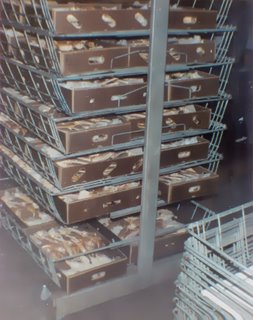The Dungy pot inventor, conical pots and black cod pots.

Ever wonder where some of the designs of things in the fishing industry came from? The gaps in my education of crab pot design just got plugged to a great degree by this fine article about an intrepid Newport, OR fisherman. He started working on prototypes of the current round design with steel mesh during the Great Depression. Then pioneered ocean fishing for dungies. Eventually going to Alaska and fishing dungies in the ocean up there.
When I got around to managing a plant, we blast froze sections of snow crab, aka. bairdi, or tanner crab.
An excerpt: "He and his two brothers saved the money to buy a small fishing boat The Falcon, the day after he graduated from high school. At that time Dungeness crabbing was done mostly in the bays, beaches and along the rocks of river mouths. But they began to "ocean crab," modifying the tall, square wood-and-string shore pots through experimentation with materials and sizes, ultimately producing the round, wire-mesh pot used in the Pacific Ocean today."
I wonder if he was running one of the boats we had fishing for us at Yakutat in 1971. We were brine freezing the dungies at the new cold storage there. (It burned down only a few years later.) We practically filled up the holding room with boxes of whole frozen crab, then flew them out on cargo planes.That was the year Louie Busanich seined roe herring for us at Whitney-Fidalgo in Yakutat then got stuck up in Russel Fjord. We had to air-drop him supplies with the DC-3 we were using to haul reds from Dry Bay.
But Petersburg had a couple of crab pot inventors as well. The two old gents that ran the Charles T were some of the first that fished for "spider crab." (That was before they invented the phrase "snow crab" to keep housewives from getting the willies.) They started using square king crab style pots but halibut would ram themselves through the openings. So they made some traps conical shaped, with the opening in the top like a trap-door spider's hole. It worked great in all respects. My father said that those two guys, running that old wooden boat of 1920s vintage, put more money in their back pockets than anyone in Petersburg. At least for their 15 minutes of fame.
Another pot design that showed up, that I played a small role in bringing to Alaska, was the collapsible, double-tunnel black cod pot. My brother Steve had asked me if I could find a design for a black cod pot. I ended up driving to Astoria and getting a blueprint for a double-tunnel black cod pot from Alan Otness, who was the Marine Extension Agent there at the time. I found out years later that the same guy that did a surf clam biomass survey in Bristol Bay for NMFS and some big East and West Coast fish processors was also instrumental in designing the black cod pot in tests off the mouth of the Columbia.
Pots are a very cost effective way to catch fish and shellfish. And you can throw most of your by-catch and little ones back alive. Probably half a dozen years after Steve fished the first black cod pots in Alaska, the St. Dominic brought us a load of live black cod from pots. I remember watching Don Williams trying to grade them live. He didn't appreciate the "freshness" when he had to put one on the scale. Pots were just too effective for black cod and are now only allowed for Pacific cod fishing in some areas of the Gulf.


0 Comments:
Post a Comment
<< Home